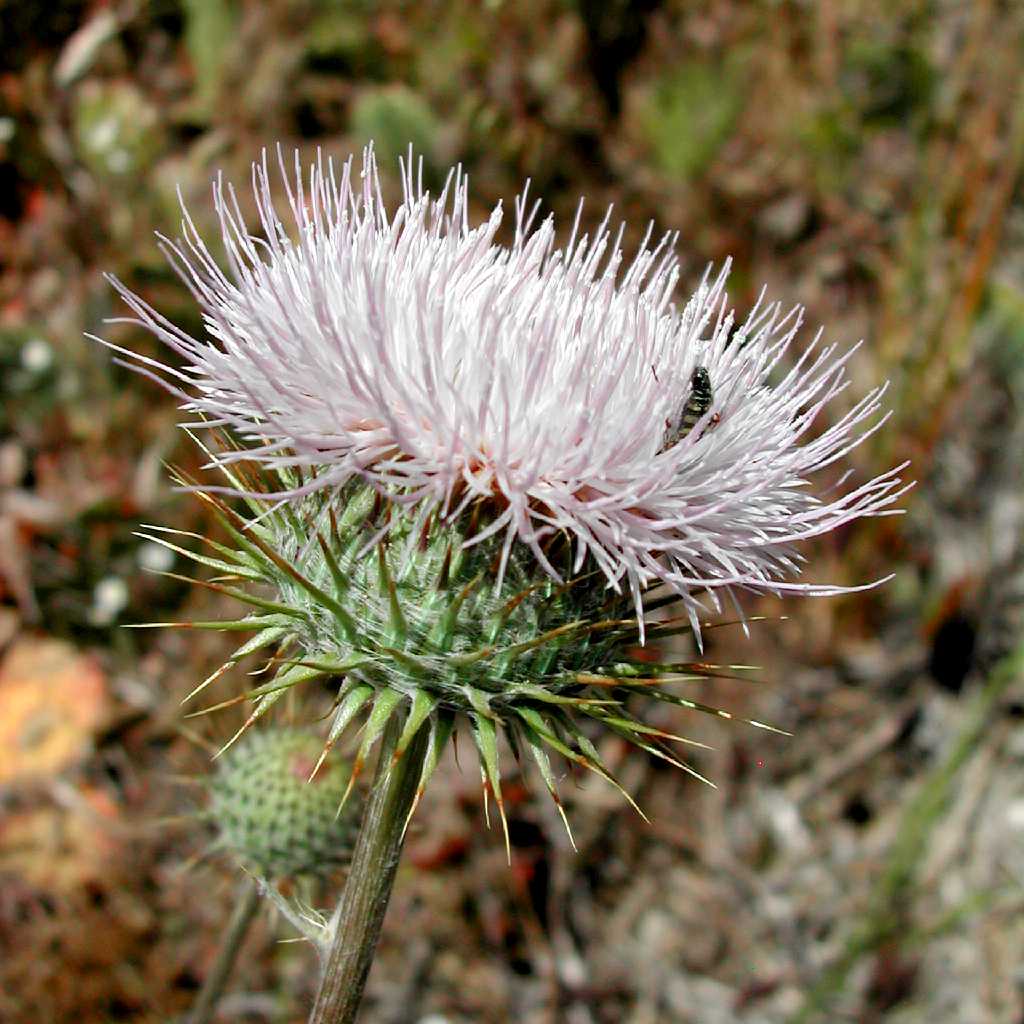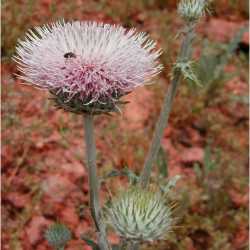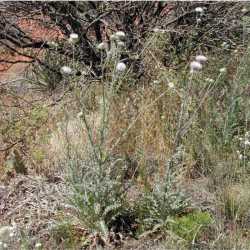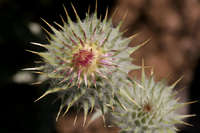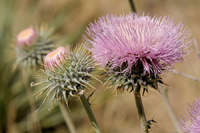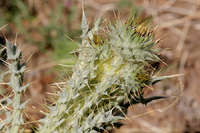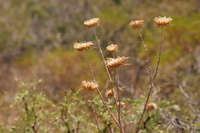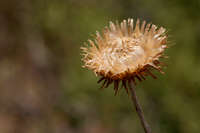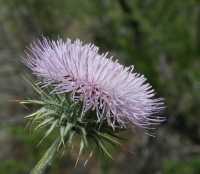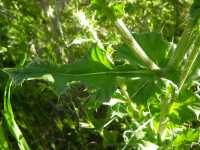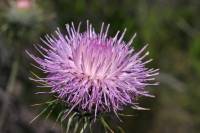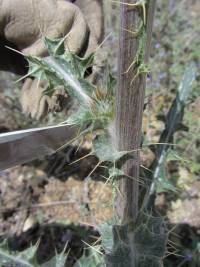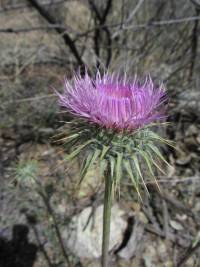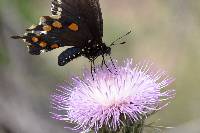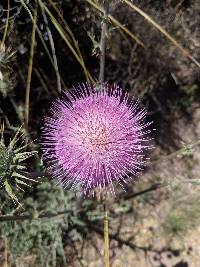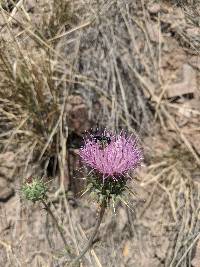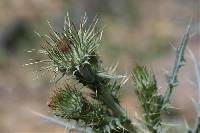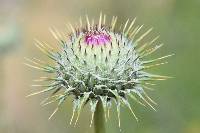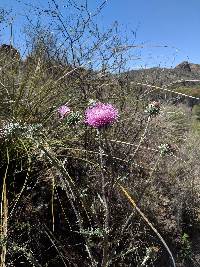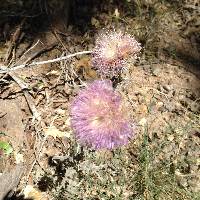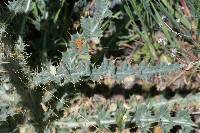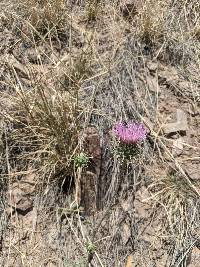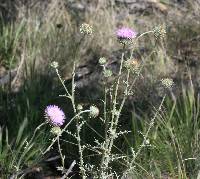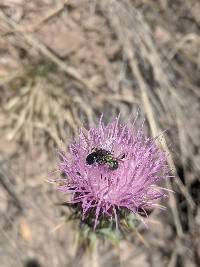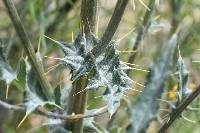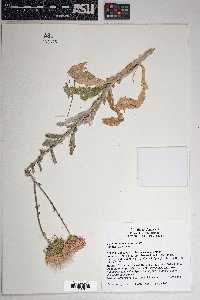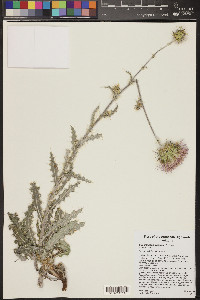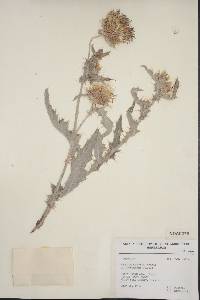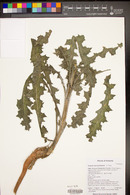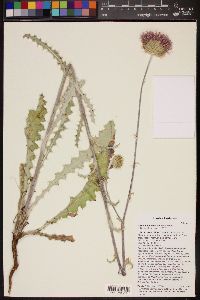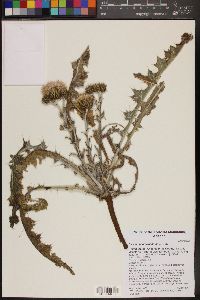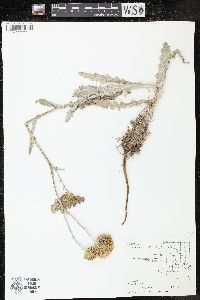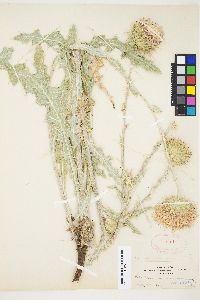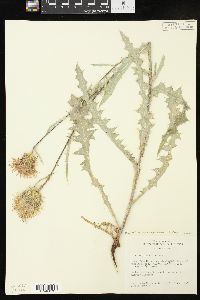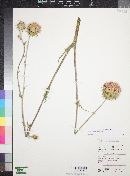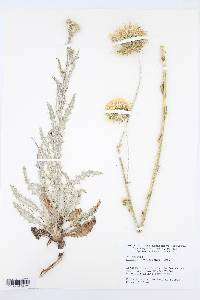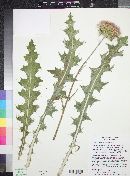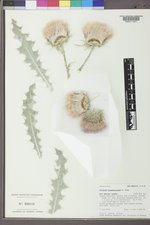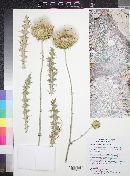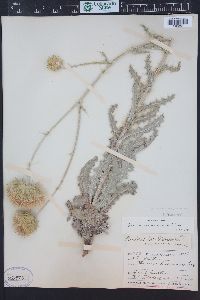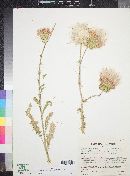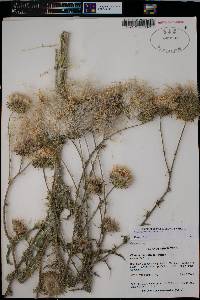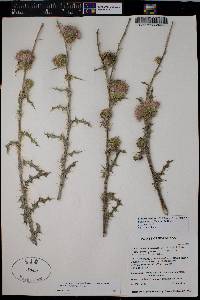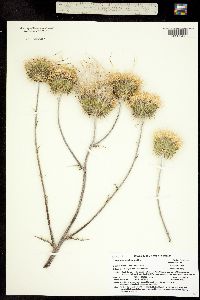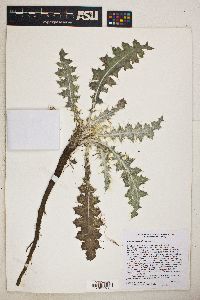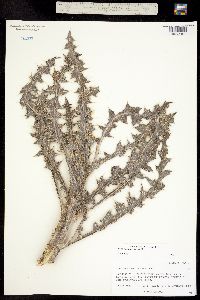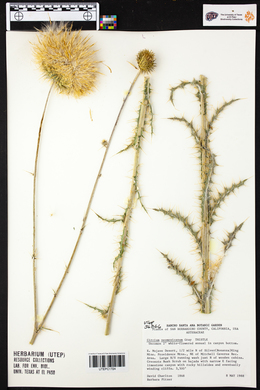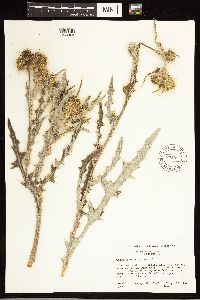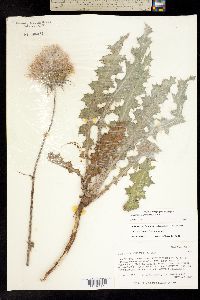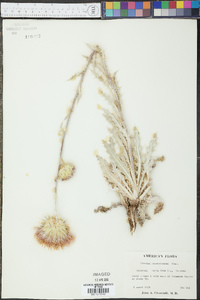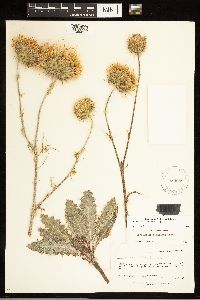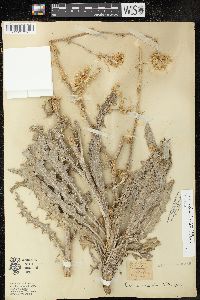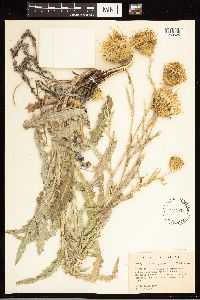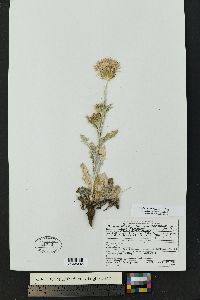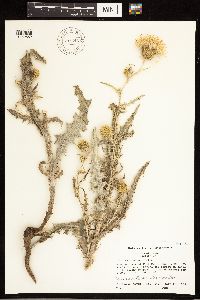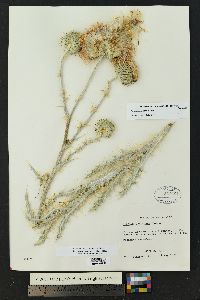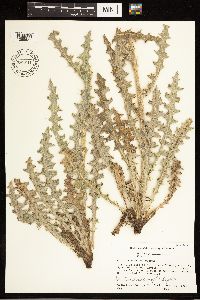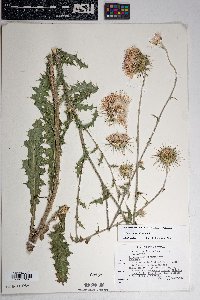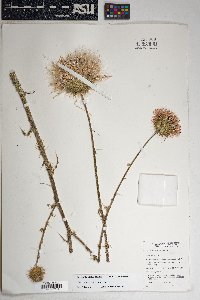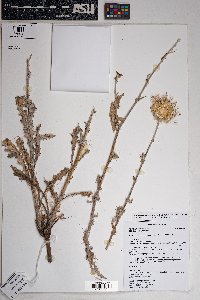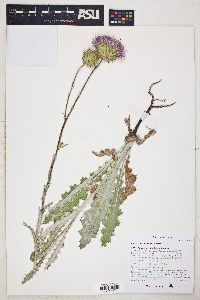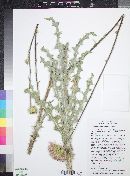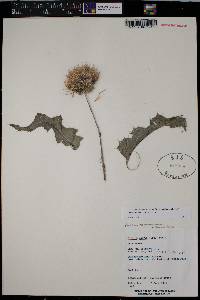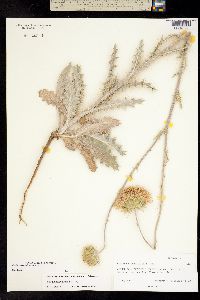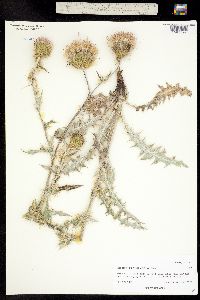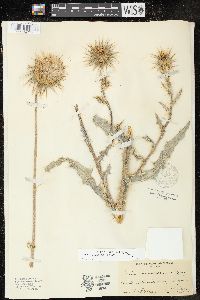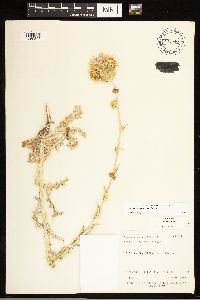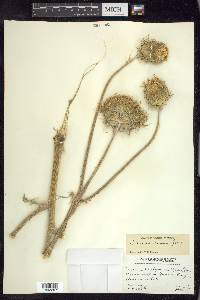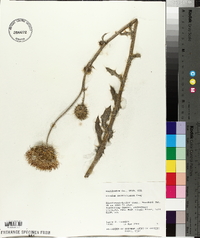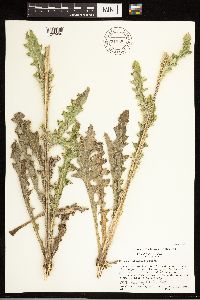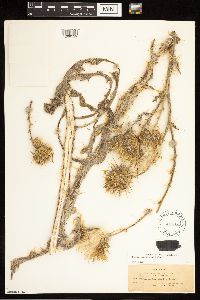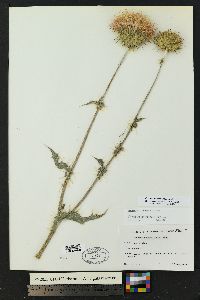
|
|
|
|
Family: Asteraceae
New Mexico Thistle, more...thistle, lavender thistle (es: cardo santo)
[Carduus inamoenus Greene, moreCirsium neomexicanum subsp. neomexicanum , Cirsium neomexicanum var. utahense (Petrak) S.L.Welsh, Cirsium utahense Petr., Cirsium wallowense M.Peck] |
Biennials, 40-290 cm; taprooted. Stems usually 1, erect, thinly gray-tomentose, sometimes ± glabrate; branches few-many, usually from above middle, ascending. Leaves: blades oblong-elliptic to oblanceolate, 6-35 × 1.5-7 cm, shallowly to deeply pinnatifid, lobes usually rigidly spreading, undivided or with 1-2 pairs of coarse teeth or lobes, main spines 5-15 mm, faces gray-tomentose, sometimes glabrate; basal often present at flowering, winged-petiolate or sessile, bases tapered, spiny-winged; principal cauline sessile, much reduced distally, bases decurrent as spiny wings less than 5 cm; distal much reduced, ± bractlike, sometimes scarcely more than a cluster of long spines. Heads 1-6 (many on large individuals), borne singly or in corymbiform arrays. Peduncles (2.5-)5-30 cm, bracted. Involucres shallowly hemispheric or campanulate, 2-3 × 2.5-5 cm, arachnoid to ± loosely tomentose, sometimes glabrous. Phyllaries in 7-10 series, imbricate to subequal, linear to narrowly lanceolate, abaxial faces with narrow or no glutinous ridge; outer and mid bodies appressed, entire or minutely spinulose, apices deflexed to spreading or ascending, long, flat, spines spreading to reflexed, 4-15 mm; apices of inner erect, often flexuous, flat. Corollas white to pale lavender or pink, 18-27 mm, tubes 8-14 mm, throats 4-7 mm, lobes 5-9 mm; style tips 4-5 mm. Cypselae dark brown, 5-6 mm, apical collars not differentiated; pappi 15-20 mm. 2n = 30 (as C. utahense), 32; 30 + 1 I. Flowering spring-summer (Mar-Jul). Canyons, slopes, roadsides in deserts, dry grasslands, and arid woodlands dominated by pinyon pines, junipers, oaks, Joshua trees; 300-2100 m; Ariz., Calif., Colo., Nev., N.Mex., Tex., Utah; Mexico (Sonora). Desert thistle is widespread in the Mojave and Sonoran deserts and ranges into the southern Great Basin desert, western Chihuahuan desert, and into adjacent mountains of Utah, southwestern Colorado, Arizona, and New Mexico. The name Cirsium utahense has been widely applied in the past to plants that are here recognized as C. inamoenum. S. L. Welsh (1983) treated it as a variety of C. neomexicanum. I have examined the type of C. utahense and can find no basis for distinguishing it from C. neomexicanum at any rank. The desert thistle is closely related to C. occidentale.
FNA 2006, Wiggins 1964, Kearney and Peebles 1969, Martin and Hutchins 1980 Duration: Perennial Nativity: Native Lifeform: Forb/Herb General: Biennial herb, 30-200 cm tall, from a stout taproot; stems stout, branching above the middle, pubescent with tangled, wooly hairs. Leaves: Basal leaves sessile or with winged petioles, often present at flowering; cauline leaves alternate, much reduced distally, decurrent at the base with spiny wings up to 5 cm along the stem; blades lanceolate to elliptic or oblong, up to 40 cm long and 7 cm wide, shallowly and regularly pinnately lobed, the lobes further toothed and tipped with spines 2-8 mm long, or blades rarely almost entire with spiny margins; surfaces pubescent with tangled, wooly hairs. Flowers: Flower heads discoid, solitary or a few at the ends of stems and branches; involucre (ring of bracts wrapped around flower head) shallowly hemispheric to campanulate, 2.5-5 cm high, pubescent with tangled woolly hairs, the bracts (phyllaries) in 7-10 series, linear, the outer and middle phyllaries spine-tipped and reflexed, the inner phyllaries appressed with long, tapering tips; florets all discs, white to lavender or pink. Fruits: Achenes dark brown, 5-6 mm long, topped with a pappus of bristles 2 cm long. Ecology: Found on dry, exposed slopes, from 1,000-6,500 ft (305-1981 m); flowers March-September. Distribution: s CA, NV, UT and CO; south through AZ and NM, to n MEX. Notes: Characterized by being an erect biennial to 2m tall; the leaf bases shortly decurrent (extending down stems as spiny wings < 5 cm); flower heads squashed-ball shaped, non-drooping, white to lavender or pink, with reflexed, spine-tipped outer and middle phyllaries; and leaves and phyllaries that are tomentose (covered with long tangled gray-white hairs), with the undersides of the leaves noticeably hairier than the upper surfaces. Seeds are a favorite of Goldfinches and other birds while flowers provide nectar and pollen for bees. Host plant for Painted Lady butterfly. Ethnobotany: Taproots of young plants are eaten raw or roasted. They are often sliced, fried, mashed or ground into flour. Flowers may be eaten raw or cooked and have high nutrition content. Navajo use for chills, fever. Used also as a panacea as root infusion, especially for colds. Etymology: Cirsium is Greek for thistle, while neomexicanum means of or from New Mexico. Synonyms: Cirsium arcuum, C. humboldtense, C. neomexicanum var. utahense, C. undulatum var. albescens, C. utahense Editor: SBuckley 2010, FSCoburn 2014 |
|
|
|
This project was made possible in part by the Institute of Museum and Library Services [MG-70-19-0057-19].
Powered by Symbiota

